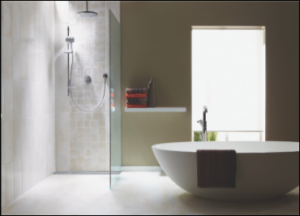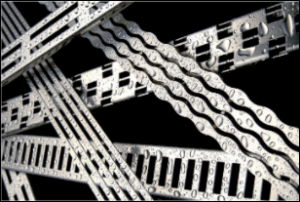What to Consider When Opting for a Curbless Shower
January 22, 2021
A curbless shower is a wet area free of a barrier or obstacle at the entry into the shower space. Years ago, a curbless shower was better known as a walk-in or roll-in shower (for wheelchairs). Basically, there was no door or obstruction to step or roll over.
It used to be seen as something for the elderly or disabled, but today, curbless showers combine comfort, safety, and style for everyone. With no tripping hazards to be concerned about, the youngest child to the oldest adult can feel secure entering the shower.
Let’s take a look at some of the advantages of a curbless shower:
- Bigger is Better: Upping the style ante, curbless showers showcase larger-format tiles and reduce grout lines for easier cleaning. And using large tiles throughout the room, from the floor into the shower, can make a small bath appear larger.

- Endless Options: Linear drains offer expansive tile options, making it easier to construct shower floors using larger ceramic, porcelain and stone tiles, as well as solid surface materials like marble, granite and engineered stone products. This is good news for homeowners, as they can create the fully customized spa bath of their dreams in their own home.
- Added Accessibility: Beyond style, curbless showers are also known as zero-entry showers. These barrier-free showers offer better accessibility to all age groups and abilities. Linear drains in curbless showers are the ideal design solution for creating ADA-compliant showers and wet spaces that are universally accessible. With only one slope and no barrier to cross, the floor more easily accommodates a freestanding bench, a wheelchair or other mobility aid.
As with any construction or remodel, if curbless showers are not correctly planned and designed, water will not drain properly or — worse — leak all over the space. Properly installed curbless showers are beautiful additions to any home.
What to Consider When Opting for a Curbless Shower:
1. The Drain Location
The first thing to consider when putting in a curbless shower is the linear drain location. Installing the linear drain at the shower entry is the easiest installation for a curbless shower, because the sub-floor is not required to be recessed. The latter means there is no need to raise or lower the shower or bathroom floor to hide the slope.
Furthermore, if the drain is installed at the entry to a curbless shower, the shower’s flow rate capacity will drop down to five gallons per minute (gpm). Today’s standard flow rates are well within this 5 gpm standard, most having been reduced to 1.5 gpm. However, you cannot have ceiling showerheads, body sprays, and hand showers all activated at the same time when your drain is located at the shower entrance, because their combined flow rate will exceed 5 gpm.
A back-wall drain install will handle up to 10 gpm, and is therefore the best location if multiple shower and hand sprays will likely operate at once. If you plan to install the drain against the shower’s back wall, the shower pan will need to be recessed, or the bathroom floor will need to be raised to hide the slope. Although this type of installation will take more time, it is the best possible placement for effective drainage.
The next step is to identify the product you would like to install.
The best approach is to contact the manufacturer directly to be sure you have identified the best-suited solution for your location and plumbing configuration. A manufacturer can put together a materials sheet, including everything that a homeowner can hand over to the installer. Next, it is important to hire a trained professional to ensure proper installation.
2. The Type of Linear Drain
A linear drain used in a curbless shower should extend vertical surface to vertical surface (wall-to-wall) promoting the effective drainage of water. Be sure that the linear drain has integrated slopes built into the drain body to efficiently and effectively evacuate water from the drain body.
 3. Tile and Drain Cover Options
3. Tile and Drain Cover Options
When considering tile choices, keep safety in mind. Surfaces tend to be slippery when wet, and a tile such as polished marble could result in a fall hazard. Don’t let style or fashion override safety. We suggest using a more natural surface.
QuickDrain USA offers a variety of linear drain covers, available in brushed and polished finishes. The late Michael Graves, one of the most prominent and prolific American architects of the late 20th century, felt that every home should have at least one curbless shower—and its affordability should not be a hurdle.
He collaborated with QuickDrain on two ADA-compliant drain covers that reflect his iconic Postmodernism outlook. Grave’s Cosmo and Stream cover designs are crafted from durable 18-gauge, 304 stainless steel. 
The both of these removable, slim-profile covers are offered with a brushed stainless steel finish, while the Cosmo is also available in a polished stainless finish. Five additional cover designs round out the seven available options for the ShowerLine drain series, including a TileIn cover.
The TileIn option is designed to accept an insert of the same tile or solid-surface material used in the shower to yield a drain that virtually “disappears” into the floor.
Conclusion
Curbless showers fit in any home, lifestyle or décor. Every homeowner can reap the benefits of a curbless shower. For example, toddlers can simply walk in, versus climbing in, and parents do not have to worry about trips and falls. For adults, after a workout or a long day at work, there is no obstruction to washing away the worries of the day.
A curbless shower is a perfect solution for safety and aging in place. Every home should have at least one curbless shower.

